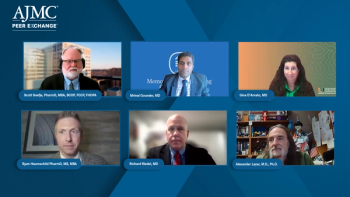
Collaborative Care Driving Optimal Care for Patients Diagnosed with HIV
Dr Welch leads a discussion on collaborations between payers, patients, and providers to optimize the care of patients with HIV.
Episodes in this series

Adam C. Welch, PharmD, MBA: We talked about Ryan White [HIV/AIDS Program] and its success. We talked about what you’re doing in Florida and its success. How do we replicate that model throughout the country? What are the essential components of working together in the best interest of our patients?
Alina Orozco, RN: Simply Healthcare Plans and Clear Health Alliance are part of Elevance Health. From our perspective, we’re starting to create HIV Centers of Excellence, and we’re communicating on a regular basis with other health plans in Louisiana, New York, and West Virginia to share information and best practices and what has worked in different areas. It may not be replicable in every market, but it’s something that we can definitely do. It’s 1 step in the right direction: communicating with other individuals and seeing what’s working for them that could be adopted.
Ann Khalsa, MD, MSEd, FAAFP, AAHIVS: Dialogue and advocacy are critical. Within our respective regions, we have to have a seat at the table and represent the needs of our patients. Our patients need to be there, but it needs to be a comprehensive review of their needs. As we have alluded to, social determinants of health are critical, and too often they’re missing. Not every state Medicaid plan has chosen to partner equally. Some state Medicaid plans have explicitly put up a lot of barriers that prohibit certain individuals from participating. But that’s limiting the ability to look at the best evidence and make sure we’re being holistic in our approach beyond cost containment. Because if you don’t meet the underlying needs, your costs are still going to soar no matter how inexpensive the drugs are that you’re pretending to use, even when they cause problems.
Shauna Applin, ARNP, CNM, AAHIVS: In our state, I’ve seen a model of partnering providers with the state health department. But there’s still a missing piece: the health care authority or whoever makes decisions on the Medicaid side. That’s a critical coming together because we have patients, advocates, and HIV specialists there. The state sets the goals for HIV elimination along with the payers. That’s a critical coming together.
The other thing is that we don’t come together out of reaction when there’s something about to change or a threat of funding changing. It needs to be a proactive conversation that’s ongoing. We’re looking at the long-term costs rather than the threat of what’s to come because then there are knee-jerk reactions and quite a bit of emotion turns out. But if we could be proactive in these bodies coming together and trying to maximize the services from each standpoint, that would be critical.
Christian B. Ramers, MD, MPH, FIDSA, AAHIVS: I have 1 final thing to add. We all have common goals. It’s very clear what our metrics should be: getting patients into care and getting them virally suppressed. That benefits everybody—patients, providers, and payers. Payers can contribute a little more to the data component. They’re the ones paying for all those pharmacy costs. They’re paying for the lab tests. They have a lot of information about the patients that the health authority or the public health department could benefit from. There have been some examples, like the Data to Care initiative in Seattle and King County [Washington], where having the viral load information would be very helpful to find those individuals who are out of care and not suppressed. We need to break down the silos and work together toward that common goal.
Adam C. Welch, PharmD, MBA: You’re treating the viral load, but it’s really tunnel vision. You need to treat holistically the entire patient and all the factors involved. It takes a whole team, and we have to look down the road at the impacts of the decisions we make and how that will affect treatment in 10, 20, 30 years.
Ann Khalsa, MD, MSEd, FAAFP, AAHIVS: Part of the unspoken steps in getting to viral load suppression that’s implicit in the Ryan White model—we call it the care cascade or treatment cascade—is to get everyone tested. Then for those who are positive, you want to link them to care. Here’s the critical piece: you have to retain them in care. They have to maintain insurance coverage and come into clinic routinely to get their labs and their meds, and then have viral loads that are suppressed on their lab testing. This retention in care is 1 of the key metrics that Ryan White monitors. That’s what Christian was speaking to. But we need to have resources. If we find, “This patient has had more than 6 months since their last labs, and they’re not coming into clinic,” we need resources to find that individual, bring them back into care, and address the reasons they’re not in care. We have a great homelessness issue going on in Arizona. We’ve got the vouchers and the housing programs, but there are no housing units. We have to look at the issues keeping individuals out of care because. When patients are out of care and not on meds, that doesn’t mean they’re asexual. They are unfortunately helping drive the ongoing epidemic of 30,000 new patients a year, which is going to mean more individuals living with HIV and the cost that goes with it. We need to take that holistic approach.
Alina Orozco, RN: The Medicaid program in Florida started a housing waiver pilot program in a couple of regions. We started when COVID-19 hit. We had some barriers to address because 1 of the key pieces for reaching out to and engaging individuals who may be homeless or at risk of homelessness for services is to do it face-to-face. We were challenged in that area, so it took us a little bit. But 4 health plans are working collaboratively together. We meet on a monthly basis, share information, and work with the state. From a payer perspective, Medicaid has never worked with housing providers. It’s usually medical providers. We’re now working with housing providers, and Medicaid is reimbursing them for tenancy, tenancy sustaining, peer-to-peer [counseling], and mobile crisis management. Hopefully, we get improved data about that and it expands going forward, in Florida and other parts of the country.
Transcript edited for clarity.
Newsletter
Stay ahead of policy, cost, and value—subscribe to AJMC for expert insights at the intersection of clinical care and health economics.








































